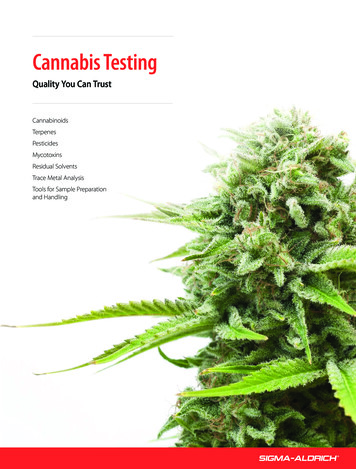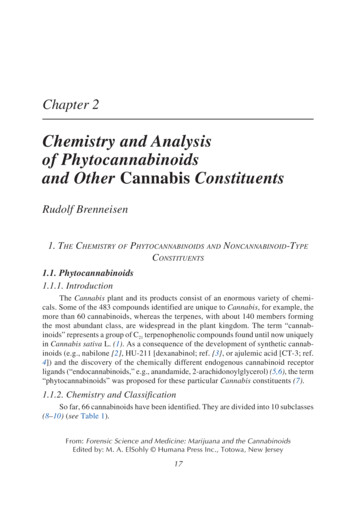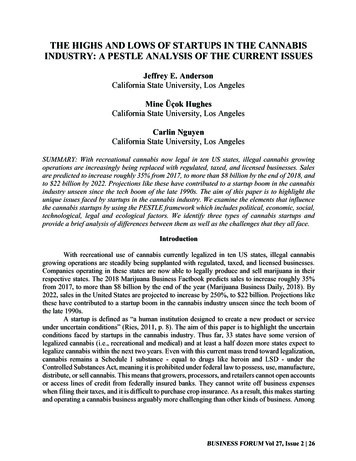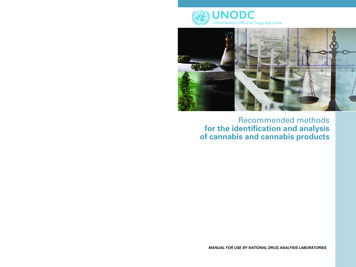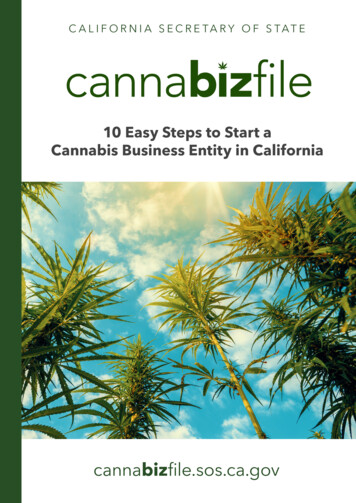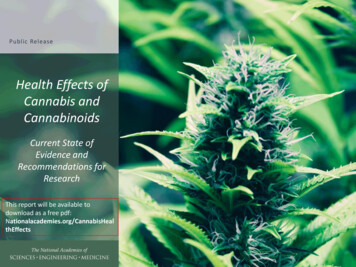
Transcription
Public ReleaseHealth Effects ofCannabis andCannabinoidsCurrent State ofEvidence andRecommendations forResearchThis report will be available todownload as a free lic Release
Today’s Presenters Rose Marie Martinez, Senior Board Director, Board onPopulation Health and Public Health Practice Leigh Miles Jackson, Study Director, Board on PopulationHealth and Public Health Practice Marie C. McCormick (chair), Harvard School of Public Health,MA Ziva D. Cooper, Columbia University Medical Center, NY Sean Hennessy, University of Pennsylvania, PA Sachin Patel, Vanderbilt University Medical Center, TN Robert B. Wallace, University of Iowa College of PublicHealth, IAPublic Release
Outline of Presentation Brief overview of study context and statement of taskOverview of study approachReport highlights and recommendationsReport products and upcoming eventsPublic Release
Brief Overview of Study Contextand Statement of TaskPublic Release
Study ContextMarijuana and Health(1982)Public ReleaseMarijuana and Medicine:Assessing the Science Base(1999)
Summary of Statement of TaskDevelop a comprehensive, in-depth review of existingevidence regarding the health effects (both harms andbenefits) of cannabis and cannabinoids useMake short- and long-term recommendationsregarding a research agenda to identify the mostcritical research questions and advance the cannabisand cannabinoid research agendaPublic Release
Study Sponsors Alaska Mental Health TrustAuthority Arizona Department of HealthServices California Department of PublicHealth CDC Foundation Centers for Disease Control andPrevention (CDC) Food and Drug Administration Mat-Su Health FoundationPublic Release National Cancer Institute National Institutes of Health National Highway Traffic SafetyAdministration National Institute on Drug AbuseNational Institutes of Health Oregon Health Authority Robert W. Woodruff Foundation The Colorado Health Foundation Truth Initiative Washington State Department ofHealth
Committee on the Health Effects of Marijuana: An EvidenceReview and Research AgendaMARIE C. MCCORMICK (chair), Harvard T.H.Chan School of Public Health, MAZIVA D. COOPER, Columbia University MedicalCenter, NYDONALD I. ABRAMS, Zuckerberg SanFrancisco General HospitalADRE J. DU PLESSIS, Children National HealthSystem, D.C.MARGARITA ALEGRÍA, MassachusettsGeneral HospitalSARAH FELDSTEIN EWING, Oregon Health andScience UniversityWILLIAM CHECKLEY, Johns HopkinsUniversity, MDSEAN HENNESSY, University of PennsylvaniaR. LORRAINE COLLINS, University at BuffaloSUNY, Buffalo, NYPublic ReleaseKENT HUTCHISON, University of ColoradoBoulder
Committee on the Health Effects of Marijuana: An EvidenceReview and Research AgendaNORBERT E. KAMINSKI, Michigan State UniversitySACHIN PATEL, Vanderbilt University Medical Center,TNDANIELE PIOMELLI, University of California, IrvineSTEPHEN SIDNEY, Kaiser Permanente NorthernCaliforniaROBERT B. WALLACE, University Of Iowa College ofPublic HealthJOHN WILLIAMS, Duke University Medical Center, NCPublic Release
Overview of Study ApproachPublic Release
Study ApproachCommittee member expertise included: substance abusecardiovascular healthgeneral epidemiologyimmunologypharmacologypulmonary health neurodevelopmentoncologypediatricspublic healthsystematic review methodologyand others Between June and December 2016, the committee held 5 inperson meetings and 1 virtual meetingThe committee held 2 open session meetingsPublic Release
Study Approach(further detailed in the full report) Adopted key features of a systematic review process Conducted an extensive search of relevant databases (e.g.,Medline, Embase, the Cochrane Database of SystematicReviews, PsycINFO)– Initial search resulted in more than 24, 000 articles– Committee considered more than 10,000 abstracts todetermine relevance for the report Primacy given to recently published systematic reviews andhigh-quality primary research that studied one or more ofthe committee’s 11 prioritized health endpointsPublic Release
Study Approach– 11 prioritized health endpoints Therapeutic effectsCancer incidenceCardiometabolic riskRespiratory diseaseImmune functionInjury and deathPublic Release Prenatal, perinatal, andpostnatal outcomes Psychosocial outcomes Mental health Problem cannabis use Cannabis use and abuseof other substance
Study approach(further detailed in the full report) Standardized language to categorize the weight ofevidence 5 levels of TELIMITEDNO or INSUFFICIENTPublic Release
Study Process– Special Considerations Biological Plausibility Considerations of Observational Studies Comparing Harms and Benefits of Cannabis UsePublic Release
Review of Select ChapterHighlightsPublic Release
Therapeutics In adults with chemotherapy induced nausea and vomiting,oral cannabinoids are effective antiemetics. In adults with chronic pain, patients who were treated withcannabis or cannabinoids are more likely to experience aclinically significant reduction in pain symptoms In adults with multiple sclerosis (MS) related spasticity, shortterm use of oral cannabinoids improves patient-reportedspasticity symptoms. For these conditions the effects of cannabinoids are modest;for all other conditions evaluated there is inadequateinformation to assess their effects.Public Release
Respiratory Disease There is substantial evidence of a statistical association betweenlong-term cannabis smoking and worse respiratory symptoms andmore frequent chronic bronchitis episodes. There is moderate evidence of a statistical association betweencannabis smoking and improved airway dynamics with acute use,but not with chronic use. There is moderate evidence of a statistical association betweencannabis smoking and higher forced vital capacity (FVC). There is moderate evidence of a statistical association betweencessation of cannabis smoking and improvements in respiratorysymptoms.Public Release
Respiratory Disease There is limited evidence of a statistical association betweenoccasional cannabis smoking and an increased risk ofdeveloping chronic obstructive pulmonary disease (COPD)when controlled for tobacco use. There is insufficient evidence to support or refute a statisticalassociation between cannabis smoking and hospitaladmissions for COPD. There is insufficient evidence to support or refute a statisticalassociation between cannabis smoking and asthmadevelopment or asthma exacerbation.Public Release
Injury and Death Cannabis use prior to driving increases the risk of beinginvolved in a motor vehicle accident. In states where cannabis use is legal, there is increasedrisk of unintentional cannabis overdose injuries amongchildren. It is unclear whether and how cannabis use is associatedwith all-cause mortality or with occupational injury.Public Release
Cancer There is moderate evidence of no statistical associationbetween cannabis smoking and the incidence of lungcancer. There is moderate evidence of no statistical associationbetween cannabis use and the incidence of head andneck cancers. There is limited evidence of a statistical associationbetween current, frequent, or chronic cannabis smokingand non-seminoma-type testicular germ cell tumors.Public Release
Cancer There is insufficient evidence to support or refute a statisticalassociation between cannabis smoking and the incidence ofesophageal cancer. There is insufficient evidence to support or refute a statisticalassociation between cannabis use and the incidence of prostatecancer, cervical cancer, malignant gliomas, non-Hodgkinlymphoma, penile cancer, anal cancer, Kaposi’s sarcoma, orbladder cancer. There is insufficient evidence to support or refute a statisticalassociation between parental cannabis use and a subsequent riskof developing acute myeloid leukemia/acute non-lymphoblasticleukemia, acute lymphoblastic leukemia, rhabdomyosarcoma,astrocytoma, or neuroblastoma in offspring.Public Release
Cardiometabolic Risk The evidence is unclear as to whether and how cannabisuse is associated with heart attack, stroke, and diabetes.Public Release
Immunity There exists a paucity of data on the effects of cannabis orcannabinoid-based therapeutics on the human immunesystem. There is insufficient data to draw overarching conclusionsconcerning the effects of cannabis smoke or cannabinoids onimmune competence. There is limited evidence to suggest that regular exposure tocannabis smoke may have anti-inflammatory activity. There is insufficient evidence to support or refute a statisticalassociation between cannabis or cannabinoid use andadverse effects on immune status in individuals with HIV.Public Release
Prenatal, Perinatal, and Neonatal Outcomes Smoking cannabis during pregnancy is linked to lowerbirth weight in the infant The relationship between smoking cannabis duringpregnancy and other pregnancy and childhoodoutcomes is unclear.Public Release
Psychosocial Recent cannabis use impairs the performance in cognitivedomains of learning, memory, and attention. Recent use maybe defined as cannabis use within 24 hours of evaluation. A limited number of studies suggest that there areimpairments in cognitive domains of learning, memory, andattention in individuals who have stopped smoking cannabis. Cannabis use during adolescence is related to impairments insubsequent academic achievement and education,employment and income, and social relationships and socialroles.Public Release
Mental Health There is substantial evidence of a statistical association between cannabisuse and the development of schizophrenia or other psychoses, with thehighest risk among the most frequent users.In individuals with schizophrenia and other psychoses, a history of cannabisuse may be linked to better performance on learning and memory tasks.Cannabis use does not appear to increase the likelihood of developingdepression, anxiety, and posttraumatic stress disorder.For individuals diagnosed with bipolar disorders, near daily cannabis use maybe linked to greater symptoms of bipolar disorder than non-users.Heavy cannabis users are more likely to report thoughts of suicide than nonusers.Regular cannabis use is likely to increase the risk for developing social anxietydisorder.Public Release
Problem Cannabis Use Greater frequency of cannabis use increases thelikelihood of developing problem cannabis use. Initiating cannabis use at a younger age increases thelikelihood of developing problem cannabis use.Public Release
Cannabis Use and Abuse of Other Substances There is limited evidence of a statistical association betweencannabis use and the initiation of tobacco use. There is limited evidence of a statistical association betweencannabis use and changes in the rates and use patterns ofother licit and illicit substances. There is moderate evidence of a statistical associationbetween cannabis use and the development of substancedependence and/or a substance abuse disorder forsubstances including, alcohol, tobacco, and other illicit drugs.Public Release
Barriers to Cannabis Research(Conclusions) There are specific regulatory barriers, including the classification ofcannabis as a Schedule I substance, that impede the advancementof cannabis and cannabinoid research It is often difficult for researchers to gain access to the quantity,quality, and type of cannabis product necessary to address specificresearch questions on the health effects of cannabis use A diverse network of funders is needed to support cannabis andcannabinoid research that explores the beneficial and harmfulhealth effects of cannabis use To develop conclusive evidence for the effects of cannabis use onshort- and long-term health outcomes, improvements andstandardization in research methodology (including those used incontrolled trials and observational studies) are neededPublic Release
Report RecommendationsPublic Release
Recommendation 1: Address Research GapsTo develop a comprehensive evidence base on the short- and longterm health effects of cannabis use (both beneficial and harmfuleffects), public agencies, philanthropic and professionalorganizations, private companies, and clinical and public healthresearch groups should provide funding and support for a nationalcannabis research agenda that addresses key gaps in the evidencebase. Prioritized research streams and objectives should include, butneed not be limited to: Clinical and Observational Research Health Policy and Health Economics Research Public Health and Public Safety ResearchPublic Release
Recommendation 2: Improve Research QualityTo promote the development of conclusive evidence on the shortand long-term health effects of cannabis use (both beneficial andharmful effects), agencies of the United States Department of Healthand Human Services, including the National Institutes of Health andthe Centers for Disease Control and Prevention should jointly fund aworkshop to develop a set of research standards and benchmarks toguide and ensure the production of high-quality cannabis research.Public Release
Recommendation 3: Improve SurveillanceCapacityTo ensure that sufficient data are available to inform research on theshort- and long-term health effects of cannabis use (both beneficialand harmful effects), the Centers for Disease Control and Prevention,the Substance Abuse and Mental Health Services Administration, theAssociation of State and Territorial Health Officials, NationalAssociation of County and City Health Officials, the Association ofPublic Health Laboratories, and state and local public healthdepartments should fund and support improvements to federalpublic health surveillance systems and state-based public healthsurveillance efforts.Public Release
Recommendation 4: Address Research BarriersThe Centers for Disease Control and Prevention, National Institutes ofHealth, Food and Drug Administration, industry groups, andnongovernmental organizations should fund the convening of acommittee of experts tasked to produce an objective and evidencebased report that fully characterizes the impacts of regulatorybarriers to cannabis research and that proposes strategies forsupporting development of the resources and infrastructurenecessary to conduct a comprehensive cannabis research agenda.Public Release
Report Products and UpcomingEventsPublic Release
Report Products and Upcoming Events Report highlights (4-page report brief)Report conclusions (a consolidated listing)Chapter highlights (a consolidated listing)2 Power Point slide sets (professionals; policymakers) February 2017 Stakeholder Engagement Meeting– open to the public; webcasted– representative of the committee will discuss the report’sfindings to a professional audience– committee will engage in panel discussions with stakeholdersof the report and will field questions from the general publicPublic Release
This report is now available and can downloaded as a free pdfat: nationalacademies.org/CannabisHealthEffectsThank you for your support ofthis important study.Questions?Public Release
Public Release
cannabis use and changes in the rates and use patterns of other licit and illicit substances. There is moderate evidence of a statistical association between cannabis use and the development of substance dependence and/or a substance abuse disorder for substan
